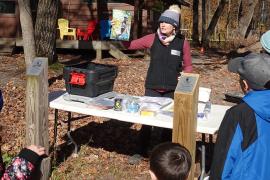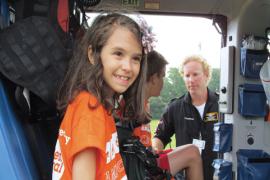“I have a new idea for a program!” This is a statement my wife hears from me on a regular basis. We have owned our own private day camp, Triple C Camp, since 1999. We serve children and youth in Charlottesville, Virginia, and surrounding areas. After the process of searching for a camp (we toured over 100 camps), finding “the one,” agreeing to a purchase price with the sellers, getting bank financing, moving our family, and closing on the property/business, we thought we were home free.
As the years went on, though, we were always looking to find more ways to generate revenue. In 2001, we built a ropes course to host year-round groups and use for team building and high climbing during the summer. This was fantastic! We were bringing in much more money than we were spending for the ropes program, as my wife and I were facilitating groups with very few part-time staff, and we were making use of the facility in the spring and the fall.
We also did in-school team-building programs at twenty local elementary, middle, and high schools in our area. A decade later, we were continuing to look for other revenue streams. We’ve always loved the “green movement” — we believe in “no child left inside.” So we started opening our facilities and programs to teachers and schools to make an impact and some money along the way.
The Green Adventure Project
In the beginning stages of the Green Adventure Project (GAP), we knew we had to get buy-in from teachers, who could then potentially encourage their schools to book trips to camp. We recognized that teachers liked the idea of environmental science field trips and that the field trips helped them with standardized testing. However, we also knew that the money for science programs could be a bit harder to come by.
In order to encourage schools to participate, we started approaching teachers to attend one of our field investigations. These are offered three to five times a year as a “teach the teacher” opportunity. If a teacher is interested, we outline the costs, identify a date, and work with the teacher to find sources of funding to help offset the costs.
Partnering with Schools
We started speaking to schools in the area to find out if they were interested in partnering for outdoor nature and science programs that would help them prepare their students for standardized testing. We found several teachers and a few advocates from our local superintendent’s office who were very excited about this possibility.
Curriculum for GAP is aligned with state standards. We created a program menu for teachers based on topics taught to specific ages. We invested in an executive director and program director who are experienced in developing curriculum. GAP works with six counties and more than thirty schools at this time, and we offer year-round programming.
Creating a Nonprofit
The biggest obstacle for GAP was cost. We wanted to tap into nonprofit opportunities for grants and fundraising (although, it’s important to note that building the reputation of a nonprofit and obtaining these financial benefits can take years). So we approached a local attorney whose specialty was nonprofits, and he advised us to form a nonprofit. This was a bit intimidating since most camp directors don’t have a legal background. We were concerned about fees, but were able to negotiate a set fee for incorporating GAP as a nonprofit.
Our attorney explained that there was no problem forming a nonprofit; however, it was imperative to keep all financial matters from our private business / summer camp (S corporation) completely separate from anything we were doing with the nonprofit. We set up a separate ledger in QuickBooks for my wife, who is our CFO, and kept all income and expenses for GAP completely separate.
We were committed to doing everything the right way, so we followed the attorney’s advice. These were the things we needed to do:
- File articles of incorporation. The attorney was very helpful with this. The right attorney is the key to making this happen. You need one who understands how to start a new nonprofit.
- File for nonprofit status. This was also done by the attorney, who presented documents for us to sign.
- Make any adjustments requested by IRS, such as:
- Separate the Web site for Green Adventure Project.
- Establish a phone line for Green Adventure Project.
- Establish a board of directors and manuals.
- We interviewed camp parents and community folks who have an interest in the green movement to be on the board of directors.
- It is very helpful that we have a banker and a local science teacher on our board of directors.
- Hire an independent real estate appraisal company to do a fair market analysis of what rent would be appropriate for a program like this in our area.
- This was a big deal and very expensive; however, we needed this to justify our S corporation charging rent to GAP.
- We are three years into this nonprofit entity and have not received rent yet, but the system is in place, and the bottom line of GAP improves.
- Organize, interview, and hire the proper staff to organize the programs and operate fundraising.
- It has been a challenge to find qualified staff who can teach the green programs, write grants, and handle all the fundraising simultaneously. We made use of the American Camp Association job board and biweekly professional jobs available. We received about thirty applications, which took time to sift through. We interviewed ten. All of this is very time consuming, but it is worth it when you find someone who can run programs and handle administrative work.
- It’s critical to have staff who will put in extra hours. For example, you need to count on them not to miss any deadlines, even if a grant application is due the day after a three-day canoe trip.
- Cultivate and develop relationships with granting organizations and public donors.
- This can also be difficult. When an organization is young, it does not have enough weight under its belt to be credible to some donor organizations. However, to serve more participants, funds are necessary. It is a bit of a catch-22. We believe that if we are committed to the program service, the funding will come.
- We also attend meetings and trainings offered by organizations that are connected to funding bodies. These are great opportunities to network and build relationships.
Success
During 2010, GAP served 500 participants; in 2011 we grew to 1,500. Through 2012 we will serve over 5,000. The program numbers are very exciting, but financially, GAP barely breaks even. It will continue to rely on grants and fundraising to stay in the black and pay the staff and the property/ rent appropriately. As I mentioned earlier, it is difficult for a new 501(c)(3) to get grant money; however, we are diligently working toward growing our program base to be more attractive to donors.
Our for-profit entity benefits from the public relations in the community, which brings more people to the camp property. When it can, GAP will pay rent. For now, GAP benefits from renting space at the camp, as the camp already had vehicles for travel programs, supplies, buildings, infrastructure, etc. A nonprofit program takes a while to get established. We are serving many more participants than we were previously, and we are very proud of the quality of the program. Areas of challenge that continue are finding the right part-time staff, fundraising, and receiving grants.
Any for-profit entity that wants to establish a nonprofit must think long and hard about all the upfront expenses, staffing, and infrastructure of a new organization. This includes strategic planning and organizing with banks, accountants, attorneys, and the staff for the private entity.
If there is quality programming that serves participants well, there is no better feeling in the world than helping them grow through an experience they would never have had otherwise.
Making ChangesWe didn’t just start GAP. We made dramatic changes to our property and program regarding going green, making our camp more marketable and cutting edge to our community and the region.
|
Green Adventure ProjectStarted in 2009, the Green Adventure Project’s (GAP) mission is to introduce students of all ages to the science of the natural world while providing them with sound experiential and adventure education opportunities. GAP also seeks to educate students about the importance of stewardship and sustainability. GAP uses hands-on, inquiry-based programs to enhance and extend classroom studies, giving students the knowledge to make environmentally conscious decisions. Programming occurs throughout the year for schools and groups, from half-day sessions to five-day “Expeditions.” Many of the programs start from Triple C Camp but extend to many sites around the central Virginia area, including public parks, state and national forests, and other camp facilities. For more information, visit www.tripleccamp.com/Green-Adventure-Project/Home.aspx. |
Howard “H” Rothenberg is co-owner and director of Triple C Camp in Charlottesville, Virginia. If you are interested in more information about the Green Adventure Project or starting a nonprofit, please contact “H” at [email protected].



